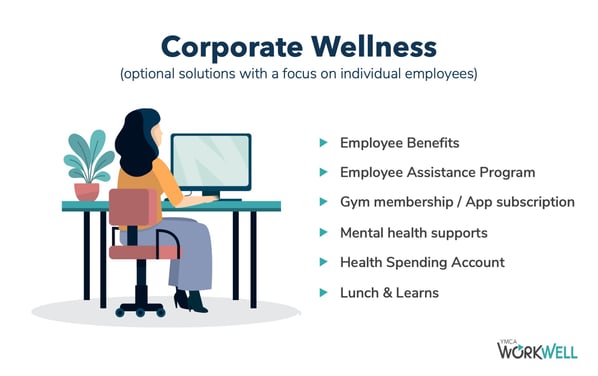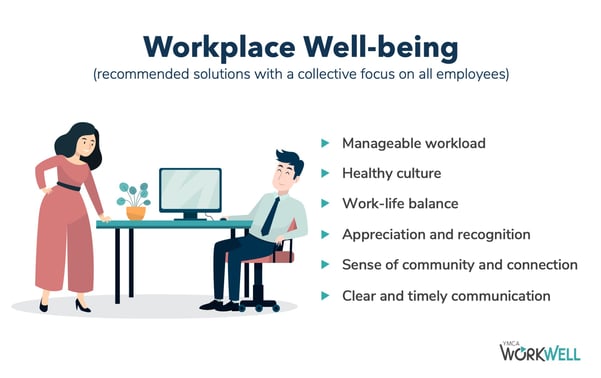This article was previously published by YMCA WorkWell and is reprinted with permission.
Renowned author and employee burnout expert Jennifer Moss argues that organizations can no longer afford to ignore employee well-being.
And, you know what? She’s absolutely right.
Multiple surveys suggest that close to half of employees are seriously considering leaving their jobs and/or changing careers in the next six months. But why this big shift? And why now?
The tide is turning…and those organizations who want to benefit from the Great Resignation – rather than be the victims of it – need to sit up and pay attention.
The disruption caused by this pandemic has been the biggest I have witnessed in my 25-year career. Everything has changed, seemingly overnight. And through this disruption, there are many good lessons and improved practices that it would serve businesses to hold on to. One of these is a greater attention to how our employees are doing, specifically more open and widespread conversations about mental health.
Employees are demanding that their employers authentically care about their well-being. Case in point: the very public conversations around return-to-office and permanent remote working, which illustrate that many are pushing back against traditional mental models of work that the pandemic has called seriously into question.
But we’re already doing well-being…
Many organizations have great wellness offerings, including comprehensive benefits plan, EAPs (employee assistance programs), subsidized gym memberships or health spending accounts, lunch and learns, break time yoga practice, a wide variety of apps. These things are all important. But they’re not the complete well-being picture.

I know what you’re thinking: wellness and well-being are two words for the same thing. That’s where we at YMCA WorkWell differ. We see a a distinction between these two terms. Corporate Wellness views health as an individual responsibility and offers a variety of supports, but employees need to do the work themselves – like all of those examples I mentioned above.

Workplace Well-being focuses on the larger context, including how the employee experience influences health in positive and negative ways. It requires a hard look at organizational norms and practices to see whether we are supporting or hindering health – things like manageable workload, work/life balance, autonomy, job control, resources, respectful workplace, and more.
While well-being encompasses your wellness program, it is not limited to it.
The essence of the problem
Your employees are exhausted. Many are on the verge of burnout, or are already there. Burnout is an organizational problem, not an individual one – and so it can’t be fixed by offering more stress management workshops or giving staff an extra week of vacation. Don’t get me wrong – I am not opposed to these efforts. They matter, and are appreciated by employees. But they won’t address the root causes of burnout.
According to Moss, we need to work more upstream and deal with the issues that are causing the burnout in the first place. These things include: unsustainable workload, micromanagement and lack of trust, lack of appropriate compensation, loneliness and isolation, and being part of an “always-on” culture.
I cringe when I see the proliferation of employee monitoring solutions and the number of companies that are implementing them. If you are willing to pay an adult $60,000 per year to work for your organization, shouldn’t you also be willing to trust them to get their work done – wherever, whenever, and however it works best for them? This requires a shift to focusing on results, not how many hours a butt is in a chair.
What should we do?
1. Check in on personal well-being
In surveys of thousands of employees over the past year, our YMCA WorkWell needs assessment data tells us that almost 40% of employees are asking for more mental health supports. This number is rising. And one thing I know about mental health from two decades of research and working in human resources is that those who are willing to ask are not the only ones who need it. We need to be prepared for the long-term mental health impacts of the pandemic.
A very simple way to start is by holding individual well-being check-ins with every single one of your employees. They can be brief, but the whole purpose of the meeting is just to talk about how they’re doing and what supports could help them right now.
2. Make sure your employees know that they’re valued
Feeling valued is about having a sense of belonging and that you bring something special and unique to the table. That you can bring your authentic self to work each day. That you both fit in and stand out.
Take time to let each employee know that they are appreciated – in the way that matters most to them. You’ll need to talk to them to figure out what that way is. And, remember, appreciation is about who an employee is, not just what they do.
Employees also feel more valued when they are seen as real people who have a life outside of work that is just as important as the job they do for you. When you have norms and policies in place that allow employees flexibility, they can decide what works best to enable them to manage all the important aspects of their lives. They can be an awesome employee and still take their kids to a swim lesson in the middle of the day!
3. Make sure workload is manageable and expectations are clear
Well-being is definitely put under pressure when individuals spend their days jumping from one task to the next, putting out one fire after another, or spending an entire day in meetings while “work” piles up on desks. On days like these, individuals go home but find they aren’t actually present with their families. They don’t sleep because their mind is working on tomorrow’s to-do list. And then it starts all over again.
A 2016 research study identified that an unmanageable workload was the top workplace stressor for one in every three employees. We’ve heard a lot about workload during the pandemic. This funny-because-it’s-so-true statement really resonated with me: “We haven’t been working from home, we’ve been sleeping at work.” Yikes!
So, what can we do for ourselves and our teams? First, prioritize. Make sure that the most important stuff is the stuff that gets done.
Second (and a key part of #1), communicate and set clear expectations.
Third, always be human. It takes a load of stress off ourselves and others when we set norms that we get a reasonable amount of work done in a reasonable number of working hours – and then we get to truly leave work, recharge, and come back tomorrow. For most of us, the world will not end if that email doesn’t get sent until the next day.
Burnout is real. Burnout is here. But, this doesn’t mean we have to simply accept it. As leaders, there are actions each of us can take to address the root causes, and help our teams – and ourselves – function in healthier ways.
Dr. Kate Toth, CHRL is YMCA WorkWell’s Director of Learning and Development. She loves to blog almost as much as she loves to develop and deliver training to help organizations enhance their culture and foster employee well-being. Her passion is to inspire others to think deeply and learn continuously. Kate has a PhD in Health Psychology and a MS in Industrial/Organizational Psychology. With a weakness for red wine and chocolate, Kate’s active lifestyle is a non-negotiable in her quest for balance.







